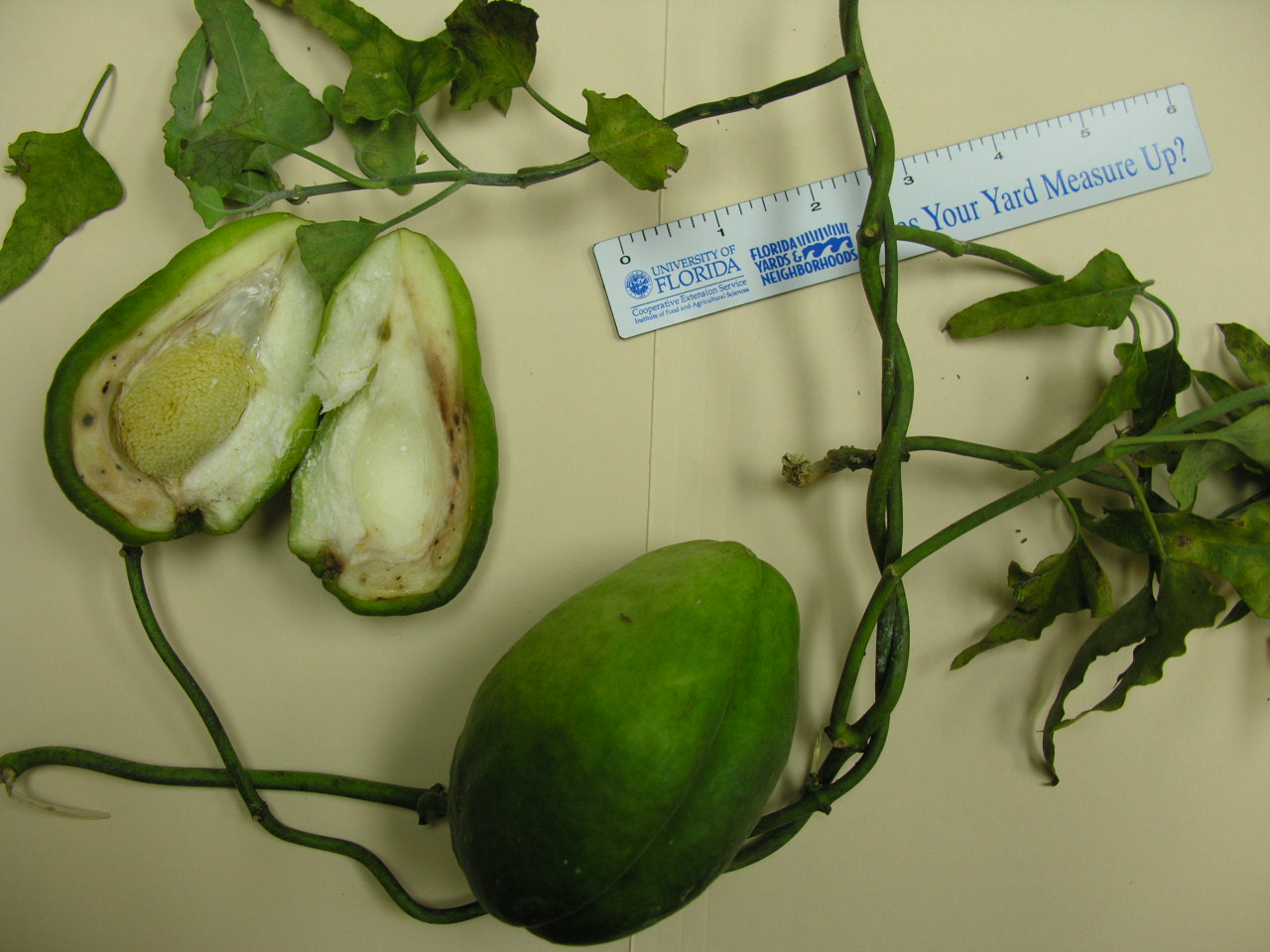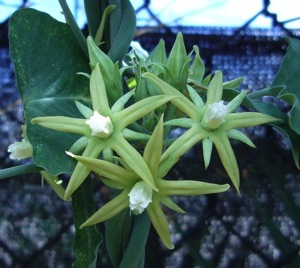Araujia odorata.: Menace or Manna?
One spring I was looking for poke weed when I spied a liana I had not seen before. It had a large fruit that looked like a chayote, but it wasn’t a chayote. I took it home, but was doubtful. It was clearly in the milkweed family and local vines in that family aren’t edible.
A couple of hours of researching and I identified the plant, a horrible weed of no redeeming value. It was first spotted in an Orange grove owned by Donald. J. Nicholson near Orlando (Florida) in 1957, apparently an escaped ornamental though the original plant was never found so how can they say it was an escaped ornamental? I suspect it was for food. I subsequently found a 1971 report that said it was cultivated in Pasco County Florida in 1939 and escaped from there and was first seen in a citrus grove in 1957. That’s when it came to the state’s attention and why it was “discovered” in 1957. Whether 1939 or 1957 it started showing up in the lower two-thirds of the state threatening citrus groves. It climbs on the trees and reduces their production, can even kill them via shade. There was no mention of it in Cornucopia II or Edible Plants of North America or any other of the five dozen books I had. So I disposed of it and deleted my pictures.
A few months later someone on a forum wondered what it was called. I couldn’t remember and I couldn’t find it again on the Internet. About a year after I first found it I was still irritated that I hadn’t found it again. I worked on it for several hours one day until I hit pay dirt. This time I also found one reference to it as being edible. That opened the door. The report was in the Journal Economic Botany, and they wanted some $38 to download the article. As I as going to Tarpon Spring for the annual Greek epiphany event — 132 miles away — I dropped by the University of South Florida on my way back (USF was named when Tampa WAS south Florida.) I rummaged around the bound copies of the journal and found the article. It said the Morrenia odorata ( now called Araujia odorata) was very edible. Highly esteemed in South America. I wonder how that was missed all these years in Florida? A January 2007 report on the plant by the state does not mention edibility.
In the Journal of Economic Botany Professor Pastor Arenas says all of the “Morrenia” species are edible. To quote the researcher:
“The fruit is the plant part most commonly eaten, but, with the exceptions of the roots, all the other organs are consumed, though the different ethnic groups vary in their preferences… The resource is prepared in various ways: Either raw, in salads, boiled, or roasted. Non-indigenous settlers use only the fruit and seeds, with which they prepare several dishes, including “doca jam,” a regional dessert made with the fruit…. The indigenous population considers it to be a very wholesome food and, despite the loss of many elements of their traditional diet, this plant continues to be highly valued. Although it is a wild plant, it is protected and even cultivated by several ethnic groups….”
According to Arenas’ monograph three native tribes eat the flowers raw. Sometimes they boil the vanilla-scented flowers, squeeze out the extra water, then mix them with oil. One group pounds the flowers and young leaves in a mortar with a little water and salt, making a salad. Three groups eat the leaves raw, another takes the leaves and the young shoot ends and make them into a crown shape. They boil it in a pan. Then the ring is drained and eaten dipped in oil. Two groups form the raw leaves, stalks and flowers into a bunch to use to absorb a preparation made of salt, wild pepper (Capsicum chacoense) and water. The bunch is dipped in the liquid and sucked until the liquid is gone.
Arenas reports the tender, immature fruits, (which I will call a vegetable) are eaten without preparation. They are consumed whole and raw. Sometimes they are mashed in a mortar, seasoned with salt and pepper. One group mixes the mashed fruit with cactus (Opuntia chakensis) which resembles bitter lemon. Not that much raw fruit can be eaten at one time because the latex in the vegetable can irritate the mouth. The seed and hairs (coma) of mature vegetable are not eaten. Depending upon the age of the vegetable it is boiled or roasted (30 minutes or so) and usually eaten with oil.
The soft stems and the ends of young shoots are often eaten with the leaves and flowers. The adult stem is a famine food, boiled until soft, the outside removed, and then eaten with oil. No fibrous or woody parts are consumed. The vine bears continuously so there can be young and mature pods on the same vine. They are collected with a long pole with a hook on the end, similar to how Ear Tree pods are collected. Extra vegetables are roasted then split in two, dried over heat or in the sun then stored once desiccated. They are reconstituted by a brief boiling then eaten with oil.
The A. odorata has other uses besides culinary. The sap can be used to curdle milk for cheese making, and there are numerous medicinal applications as well. A decoction of the plant plus roots was used to induce lactation. The latex is used to remove warts, calm toothaches and used against snake bite. The plant, interestingly, is toxic to cows and usually fatal. The sap can be used as a glue. Nutritionally the vegetable is close to squash but has a Vitamin C content closer to citrus. In fact, it has more Vitamin C than oranges.
While a staple food in Brazil and Argentina (first described in 1838) in the United States it is a “weed,” that is, on nearly every possible weed list, federal to state to local. It’s a costly vine to the citrus industry and efforts continue to find ways to kill it off. Incidentally, monarch butterflies like it but it is also a breeding ground for flies that ruin papaya.
Odorata means sweet-smelling or fragrant. Morrenia was a bit of a challenge. It was named for Belgian botanist Charles Morren, (1807-58) a professor at the University of Liege. Morren discovered how to artificially pollination vanilla. Folks had tried for 300 years to do it. His method is still the one used, per se. What he did was watch the flower. A tiny sociable bee without a stinger — the Melipona Bee– came along, lifted a little flap and went into the flower. It is the only insect that does that. But it took a 12-year-old slave, Edmond Albius, to figure out a simple way to do it with a little stick and his thumb. So the genus should be called Albiusa but instead it is now Araujia. Why? Who knows but its new name is after Portuguese botanist António de Araújo e Azevedo, 1st Count of Barca (1754–1817).
My friend, Marabou Thomas, says cooked the vegetable tastes “like some crazy combination of potato and zucchini marinated in honey.” My older pallet doesn’t pick up the honey notes but it is delicious. I am convinced that if folks knew how tasty the Araujia odorata is the state would not have to spend millions to keep it in check.
In extreme southern Florida or farther south you might confuse the Morrenia odorata with Cynanchum cubense. The blossoms of the C. cubense do not have star-like sepals. Also north of Florida don’t confuse it with the Cynanchum laeve, which has similar leaves and vine but smooth milkweed-like pods. I get a huge amount of mail from folks finding the Cynanchum laeve thinking it is the Araujia odorata. They read “milkweed” and “vine” and don’t bother to learn that A. odorata fruit looks like a roundish squash, and C. laeve is a smooth pod.
Green Deane’s “Itemized” Plant Profile: Milkweed Vine
IDENTIFICATION: Araujia odorata: A perennial, leaves grow in pairs on stems, grey-green, slight fuzzy texture. New leaves on new growth heart-shaped to 5 inches, older vines pointy, broad base, smaller. Flowers greenish-white, small, five small petals, fragrance reminds some of vanilla. Fruit large seed pod, resembles a chayote, or a papaya, or an avocado in shape, mature pods 5 to 6 inches long, 3 to 4 inches wide, green until ripe then yellow, tan, or brown, will split open.
TIME OF YEAR: Blooms heavily in mid-spring, fruits continuously, can over winter if no frosts or freezes.
ENVIRONMENT: Rain forests to dry forests, groves, anything it can climb on, bushes, trees, fences, wires.
METHOD OF PREPARATION: Numerous: Young leaves, fruit, flowers and shoot tips raw, older fruits boiled or roasted in embers (usually 30 minutes) Older stalk boiled and peeled. Older green fruit can be dried and preserved. Unripe seeds and coma are edible. Ripe seeds and coma are not edible. When roasted the inner rind flavor is similar to squash. When boiled it is more like zucchini/potatoes.
There used to be a video on You Tube of women collecting, preparing and eating the Araujia odorata in Argentina. Apparently that has been deleted. Here is my video about it.





